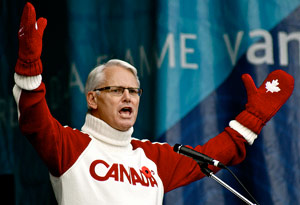
The Vancouver 2010 Winter Olympics ended more than 18 months ago. VANOC's last official public financial statement was finished almost a year ago.
But secrecy still flourishes around the Bailout Games, so named by The Tyee after cash-strapped VANOC needed more money from taxpayers to put on the Games and taxpayers kept key sponsors (like General Motors) afloat.
A four-and-a-half-year-old report examining the second version of the Games' business plan by the finance ministry's Internal Audit and Advisory Services branch sheds some new light on the the VANOC financial blueprint. But several key sections were censored.
IAAS executive director David Fairbotham's May 14, 2007 report to the B.C. Winter Games Secretariat, obtained by The Tyee under Freedom of Information, is generally favourable, though it does pinpoint numerous risks and deficiencies that would eventually materialize when the global economic boom went bust.
Bureaucrats censored sections on the $100 million operating contingency, anticipated International Olympic Committee payments and energy services. They cited loopholes to protect intergovernmental relations and third-party financial interests.
The report said the $100 million rainy-day fund was "likely to be sufficient," but there were "some uncertainties that could have a material budgetary impact" and no comprehensive strategy to avoid deficits. The IAAS review had limits of its own.
"The VANOC finance group has worked on the contingency being approximately 11 per cent to 14 per cent of uncommitted expenses," the report said. "We did not verify the percentages in our review.
"We were advised by VANOC financial management that the general feedback from these reviews was that the contingency should be adequate given the level of planning completed. Due to the informal nature of the validation reviews, we were not able to verify them."
VANOC submitted its first business plan to the B.C. and federal governments in July 2005, but the province postponed approval when VANOC sought another $110 million because the $470 million construction budget was insufficient.
The second business plan -- published May 8, 2007 -- "technically" met requirements of the Multiparty Agreement, the Nov. 2002 accord that defined roles and responsibilities of funding governments and VANOC.
Fairbotham wrote that the business plan was "at a high level and would be more informative and transparent to government partners, sponsors and the general public if it included trends to date, and information on the risks to achieving planned objectives."
Risky business, recession brewing
The redacted version provided The Tyee did not show commentary by IAAS about a key VANOC assumption: there would be no recession before or during the Games.
Despite the Games being so reliant on advertising dollars, VANOC built the business plan on a foundation assuming no recession of any size would happen.
When recessions hit, the standard first casualty is the advertising budget.
Not only was VANOC faced with declining revenues by the recession that came in 2008, but expenses suddenly escalated. The credit crunch forced many bidders for supply contracts to withdraw. Suddenly it became a seller's market and VANOC had to pay higher prices for goods and services.
When the business plan was presented to media on May 8, 2007, VANOC CEO John Furlong bluntly said the $1.63 billion operating budget was funded by four main sources: sponsorships, tickets, souvenirs and broadcast contracts.
"Entirely by the private sector, it is not funded by the taxpayers," Furlong proclaimed.
The IAAS report reveals that VANOC had its hand out, actively campaigning for more taxpayer funding behind closed doors. It asked the B.C. and federal governments for an additional $10 million each to fund the Paralympics. It wanted $20 million from the federal government for the opening ceremony.
"Neither of these funding expectations have been approved by either the Province or Canada. Although smaller in proportion to some of VANOC's other revenue sources, this is significant because this funding potentially represents additional contributions by the two senior governments," the report said.
What VANOC wanted, VANOC got. Federal Olympics Minister David Emerson visited VANOC's city-owned office building to announce the additional $20 million on Feb. 22, 2008.
"They didn't need the money, they could've got it elsewhere, but we wanted to be there," Emerson said at that news conference.
Asking for more
VANOC chief financial officer John McLaughlin wrote March 26, 2009 to the province for another $19.2 million for ceremonies and the torch relay. That extra "ask" was also okayed.
But the politicians didn't want to use the b-word, even after the Games. It wouldn't have been politically correct.
"Provincial funding did not include a bail out for the Vancouver Organizing Committee," wrote then-Olympics minister Colin Hansen in response to a July 24, 2010 email from an unidentified Tyee reader. "On the contrary, VANOC presented the provincial government with a unique opportunity to make additional investments that would help create a spectacular 2010 Games."
The IAAS report also red-flagged finalization of agreements for the provision of security and medical services for the Games. The costs and tax implications of sourcing buses from the United States "could have an impact on transportation costs and the viability of a significant element of the transportation operating plan."
Bus systems were forecast at $52.37 million in the 2007 business plan, but ended up costing $92.6 million after a dispute with Florida-headquartered contractor Gameday Management Group over the myriad subcontracts with dozens of companies for the 1,100-bus fleet.
VANOC was "pursuing a new energy model through BC Hydro" to use utility feeder sources instead of temporary diesel powered generators.
"The potential savings are material and are assumed in the budget," said the report. "However, the Olympic Broadcasting Services still needs to approve this approach and it needs to be confirmed with BC Hydro."
Energy services ended up costing $80.1 million, substantially higher than the $46.9 million forecast in the business plan. Despite it being a sponsor, BC Hydro didn't handle all of VANOC's power needs. VANOC paid GE-spinoff Aggreko $45 million alone to provide temporary power equipment at 52 venues, including the cargo container-sized diesel generator clusters on three sides of B.C. Place Stadium to keep the Olympic stadium's lights on and roof up for two months.
Premier’s promises
Before B.C. won the bid for the Games in 2003, Premier Gordon Campbell promised the IOC that taxpayers of this province would be the ultimate guarantor for any VANOC losses.
Campbell created the B.C. Winter Games Secretariat and charged it with overseeing the $600 million B.C. contribution for venues, Paralympics, medical services, security, live sites, endowments and legacies. A July 9, 2010 report showed government spending ballooned to $925 million.
The extra involvement by government sparked the IOC to make an historic bailout of its own, offering $22 million in Aug. 2009 after failing to sign the promised 10th and 11th global sponsors.
VANOC eventually revealed in its week-before-Christmas report last year that it received $74.4 million from the feds and $113.4 million from the province to balance its $1.884 billion operations budget. Those payments did not include the sponsorships sold to Crown corporations like BC Hydro, B.C. Lottery Corporation, ICBC and Canada Post. Individual contract revenue was not disclosed by VANOC and it's unlikely taxpayers will ever get an independent report card on how their money was spent.
The Office of the Auditor General of B.C. shelved a pre-Games report on provincial financing of the Games in December 2008 out of frustration with the government. Early in 2011, Auditor General John Doyle opted not to review the province's contributions. ![]()
Read more: 2010 Olympics, Politics















Tyee Commenting Guidelines
Comments that violate guidelines risk being deleted, and violations may result in a temporary or permanent user ban. Maintain the spirit of good conversation to stay in the discussion.
*Please note The Tyee is not a forum for spreading misinformation about COVID-19, denying its existence or minimizing its risk to public health.
Do:
Do not: